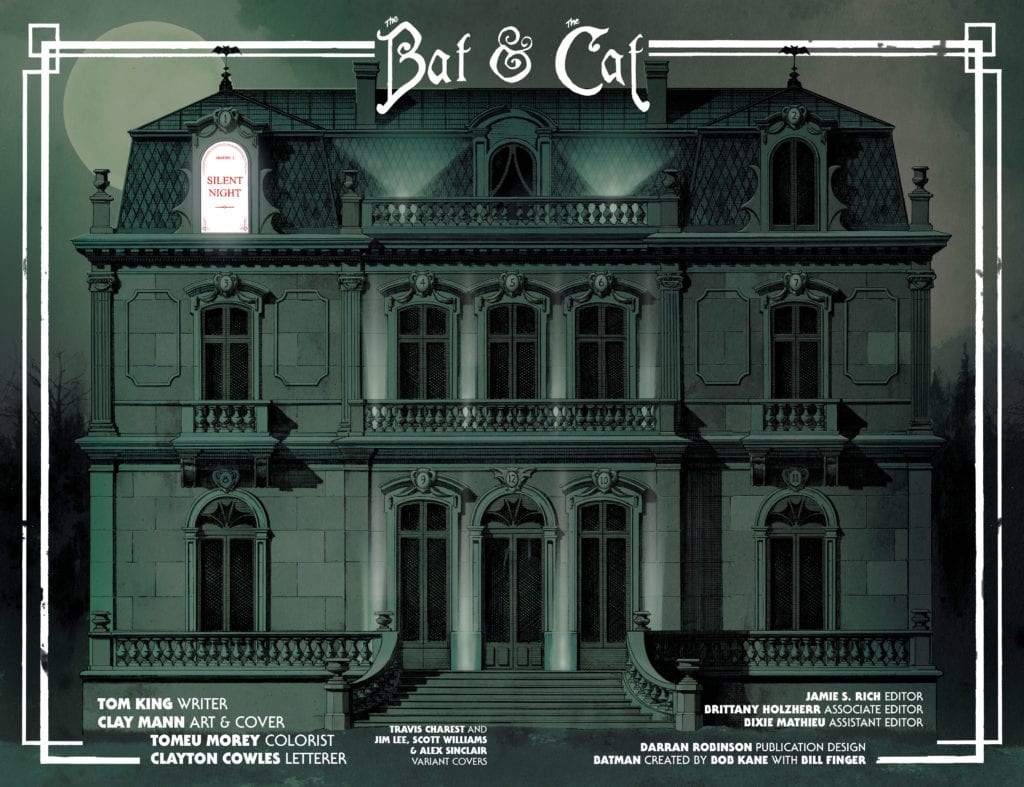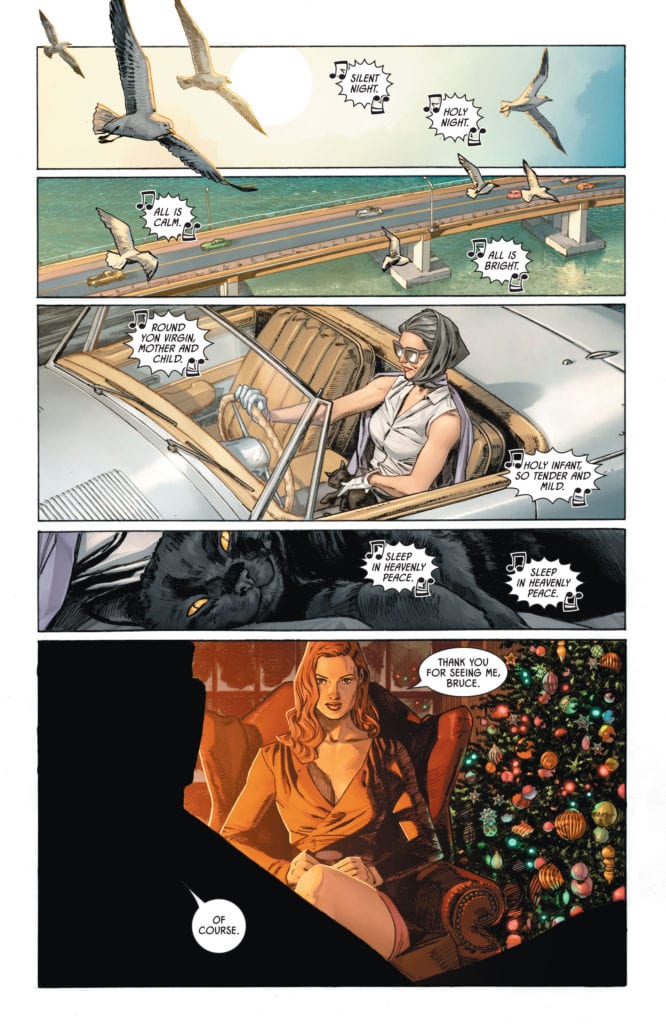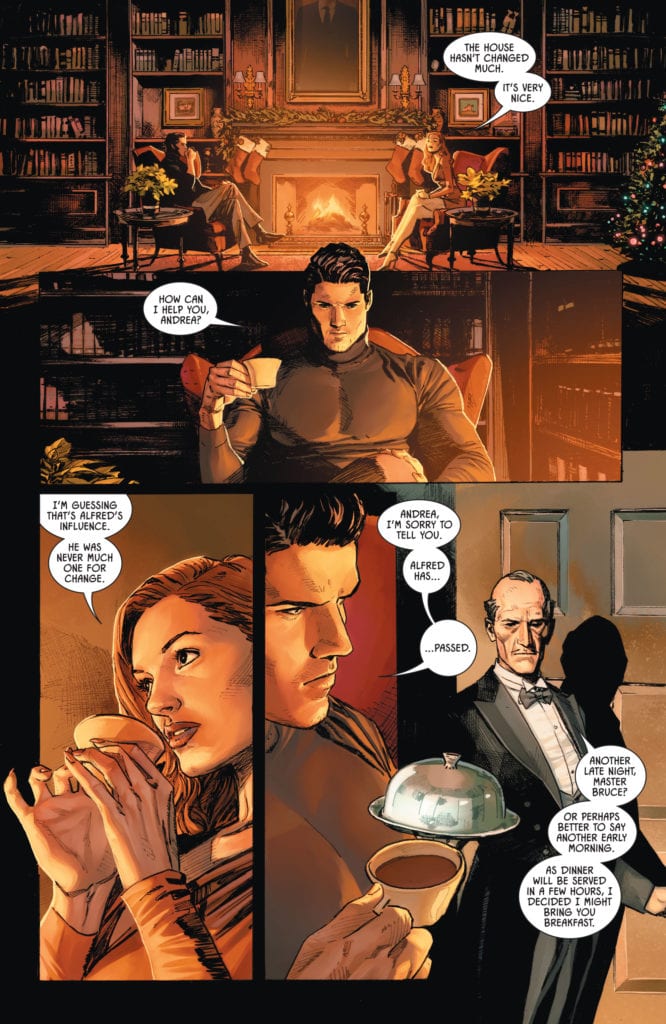There’s something to be said for “romances” that plant themselves firmly in the realm of the platonic. Stories that discuss the connection between friends, not lovers. In some ways, these stories feel like they get at something deeper. They’re not just about mutual attraction and sexual chemistry. They’re about shared trauma, laughter, and the ability to let your guard down completely. So, DC Comics’ Batman/Catwoman #1 isn’t really about Batman and Catwoman. It’s a “romance” about the friendship, or at least the complicated relationship, between Catwoman and the Joker.
Writer Tom King, artist Clay Mann, colorist Tomeu Morey, and letterer Clayton Cowles push the titular relationship to the sidelines in their new series for DC Comics. They focus instead on the undeniable connection between Selina and her friend, colleague, and enemy, the Clown Prince of Crime.

Writing
King isn’t focusing on the action in these pages. Deaths and fight scenes happen off-panel. We meet people who have somehow escaped death, but we don’t know how. Those moments don’t matter. They’re gaps we can fill in on our own. The moments that do matter to King are the quieter moments. King wants to talk about the aftermath of superheroism, the embarrassment that sets in after the adrenaline rush has subsided. And these are the scenes that count. We’ve seen the fistfights before; we know how they go. We haven’t seen Joker and Catwoman reminiscing on a rooftop as the sun rises.
King also creates a kind of distance to the events of this issue. While one timeline follows our characters in the “present,” we also follow an older Selina Kyle, years in the future, as she goes to tie up loose ends with people she and Bruce knew. Bar everything else, we know she at least survives to grow old. Present-day happenings might scar our cast of characters, and Selina suggests they do, but they won’t kill them. King wants to see what it looks like for superheroes to try and live a normal life. But what’s so telling about this issue, is normality doesn’t sneak in when Selina and Bruce get together. Their relationship is larger than life, it’s mythological. No, normality sneaks in when she and Joker discuss how she’s changed. Knowing Selina outgrows her life as Catwoman almost makes her time with Bruce seem silly. It’s when her guard comes down, and her mask literally comes off, that feels like a respite from all this play-fighting through the night.
Art
Mann doesn’t stay within the lines. Characters jut out of the panels they’re in. Sometimes it’s just an elbow or a forehead that sticks into a neighboring panel, other times they tower over a separate scene. Mann uses this as simple way of creating a flow on the page. One panel seamlessly blends into another. But sometimes, Mann is showing us something important. As an older Selina talks with another character, we see a scene of her and Bruce, jutting into this scene from the future. The scene feels like it’s living in the shadow of the past. As she and her friend weep together, we see how much their lives are marked by times gone by. Maybe they’re chasing that feeling, the feeling of being an important player in the world. Maybe they wish they could forget it all. Either way, their present is inextricably tied to their past.
When the Joker and Selina talk about each of their lives’ new direction, Mann shows us how Joker is beginning to feel about Selina. Mann splits a panel of each of their faces in half, so they look like two sides of one person. Mann shows us their kinship, how they’re not that different. Joker was once her colleague, maybe even her friend, now she’s sleeping with the enemy. We see an image of Batman at the top of the page, and Joker’s head and shoulders are superimposed over it from the panel below. He and Batman are facing different directions. The Joker looks alone, even hurt. It’s as though he feels he’s lost a friend. His back is to Batman and Selina like he’s third-wheeling and left out in the cold. It’s incredible. He’s a villain, a murderer, a psychopath. Mann somehow keeps him dangerous, yet also makes him relatable.

Coloring
Morey gives us all the more reason to sense a connection between Catwoman and Joker. Throughout the issue, Morey uses purple and green. At first, this seems like it’s just the colors of the Joker. But Morey reminds us there are versions of Catwoman’s costume that were also purple or green. Yet the purple and green don’t stop at their fashion sense. It colors nearly every scene that they’re in. Whether it’s the purple sky of a sunrise over Joker and Selina talking, or the green alligators Batman and Catwoman are fighting off, or the color scheme of an old friend’s home. The only other color that takes up quite as much space is red. Red becomes the overpowering color of all of the most dramatic scenes. Whether it’s the sky in the background as Catwoman and Batman hunt for criminals, the red shirt of an old man trying to live down his past, or the red glow of the fire as Bruce catches up with an old flame. These are the moments of the golden age. The moments that feel important. Red is the passion, the violence, the blood, and the lust that fills a hero’s life.
Lettering
Cowles uses a clear symmetry on the page to tell us something about each character and how they relate to one another. He shows a mutual respect between Catwoman and Joker. Their word balloons mirror each other, almost as though they reach out to one another. At one point, as Catwoman is dangling from a ceiling, we see her dialogue stretch downwards. She’s speaking to Joker, who is sitting elsewhere in the room, waiting for her. His words go up to meet hers. And later, as we see they are almost merged on the page, their dialogue comes to the middle. Each line getting closer to touching the others. It’s this mirroring that makes them feel like equals. They speak to each other on the same level, literally. There’s no talking down or one-upmanship. They’re people who understand one another.

DC Comics’ Batman/Catwoman #1 is sneaky. It pretends to be a Bat/Cat romance, to get its foot in the door. Once it has, it invites you into a beautiful meditation on friendship, trauma, and the people in life you can never quite shake. This creative team lays out the complicated history of a superhero and the even more complicated history of a couple of supervillains. It’s brilliant, it’s shocking, it’s simple, and it’s oh so complex. DC Comics’ Batman/Catwoman #1 is the start of a rule-breaking, ass-kicking series that’s going to leave a mark on Gotham City forever. Pick up Batman/Catwoman #1, out from DC Comics December 1st, at a comic shop near you!

